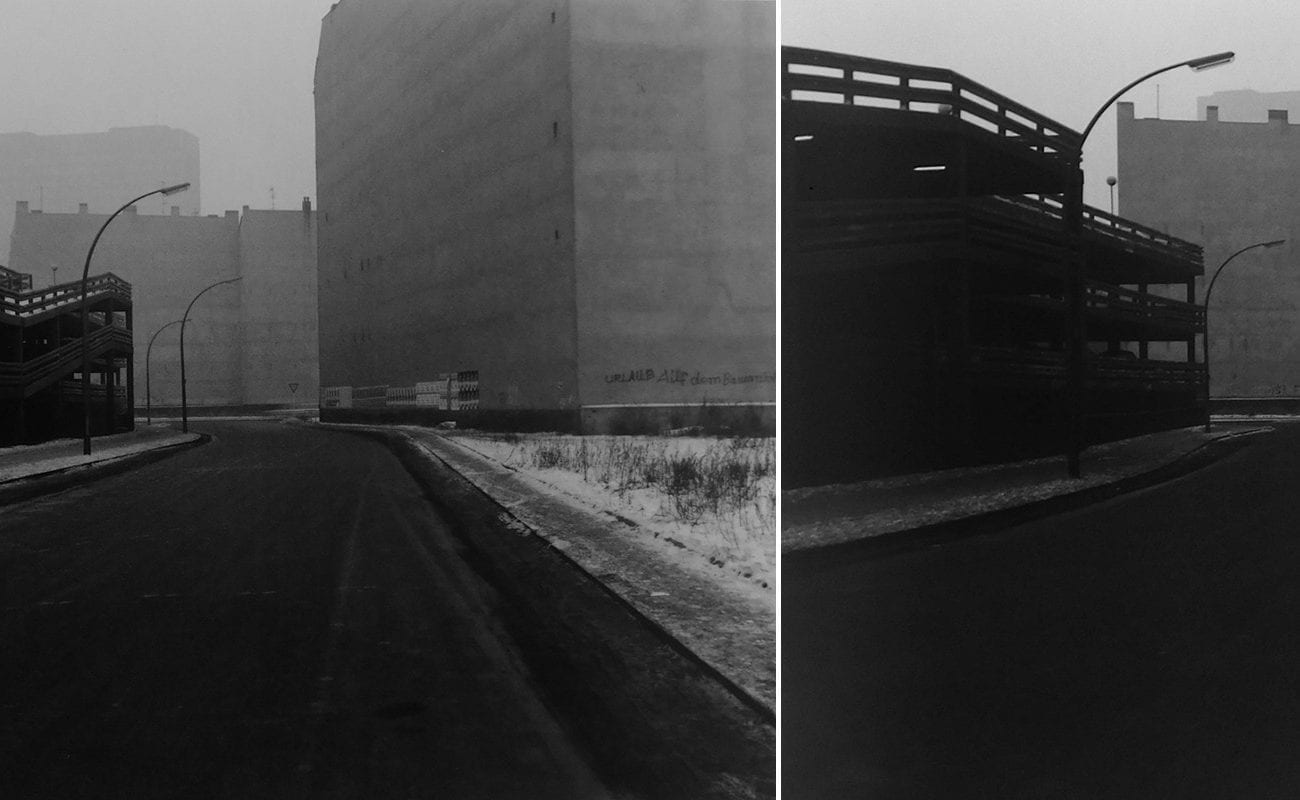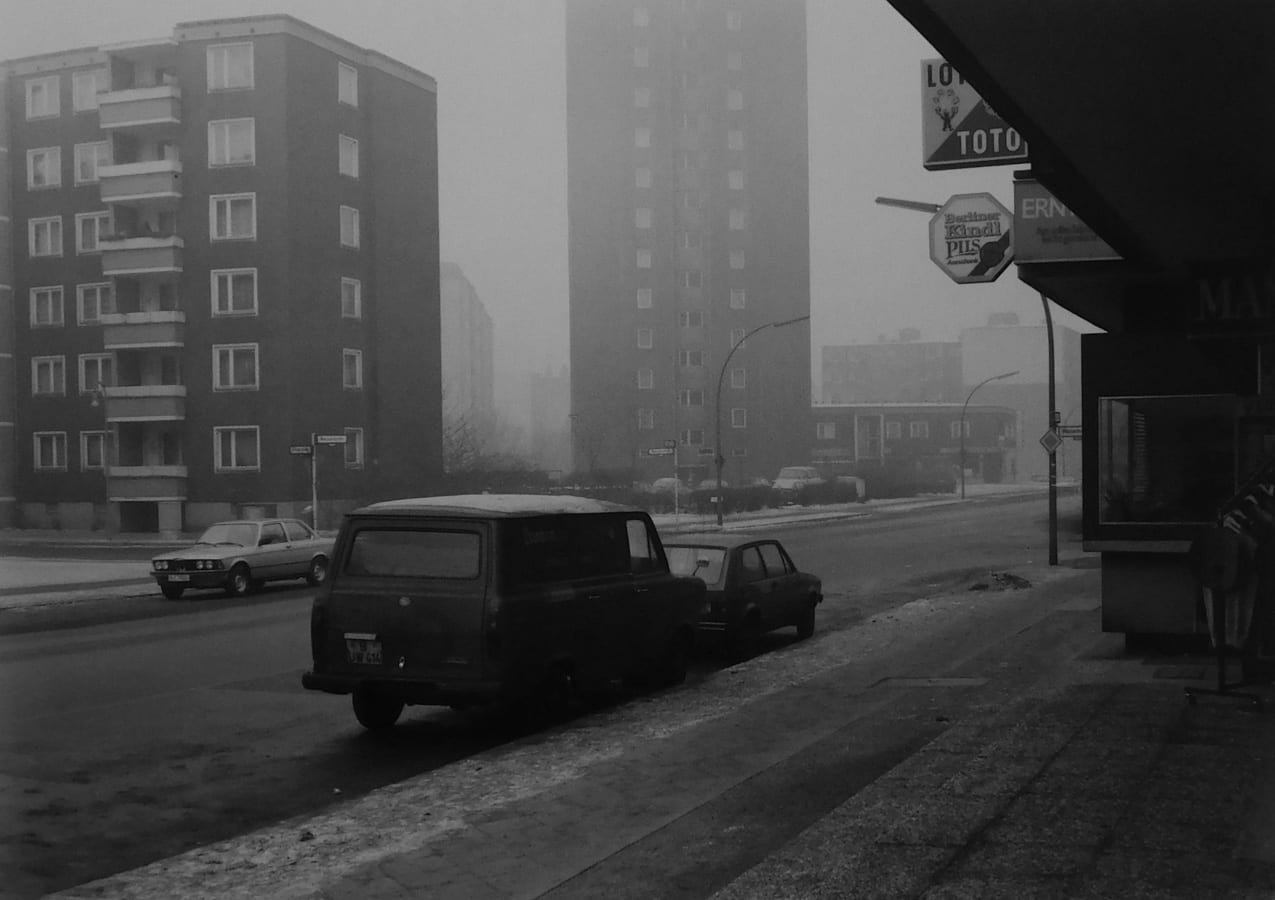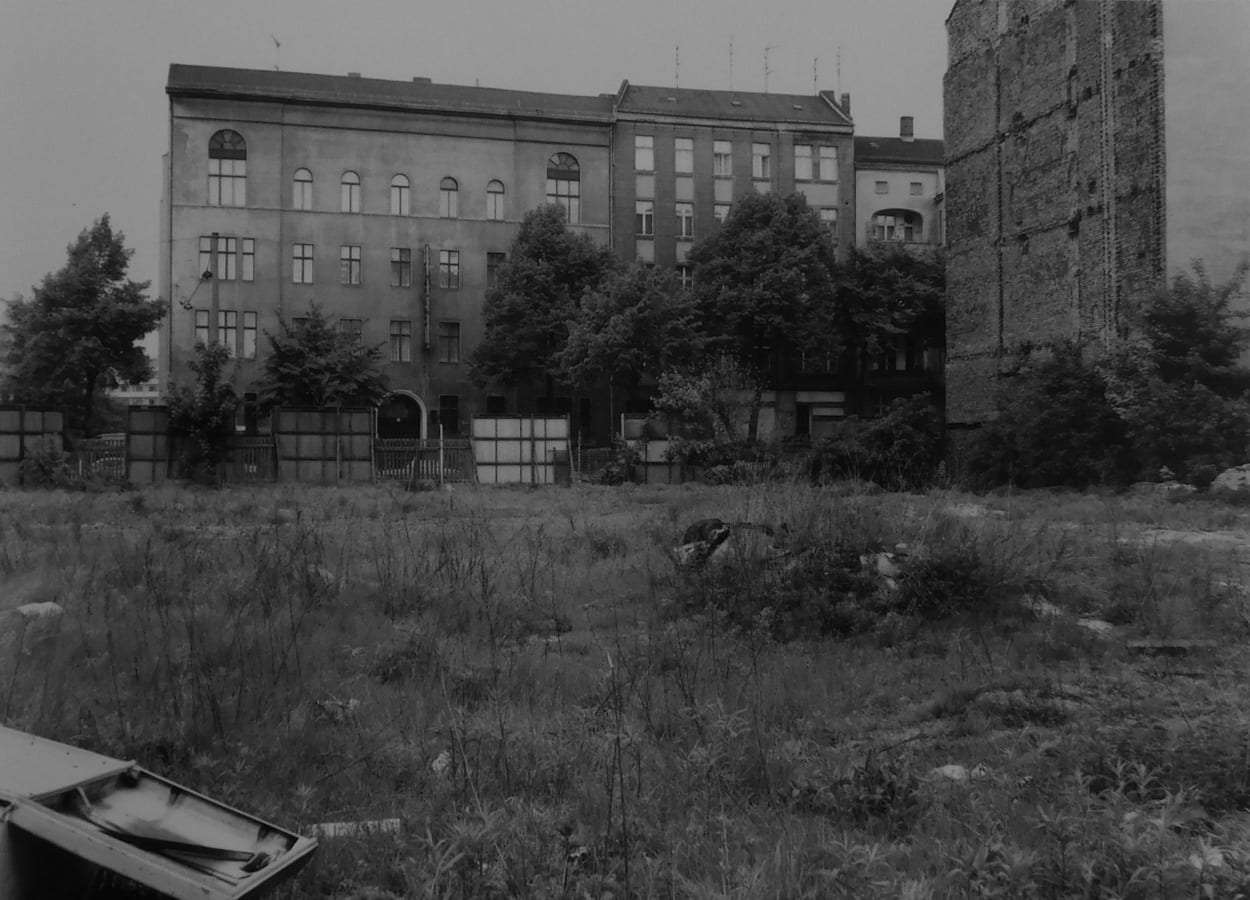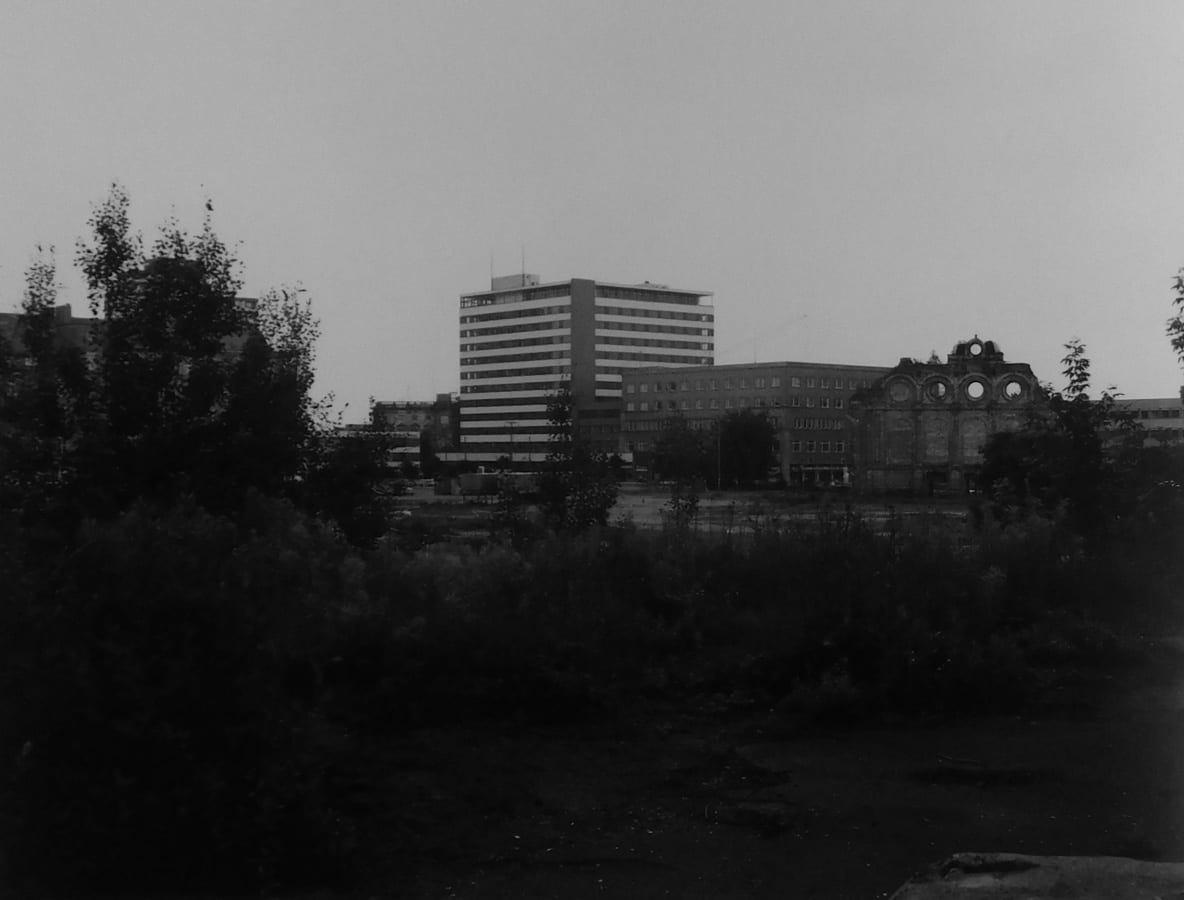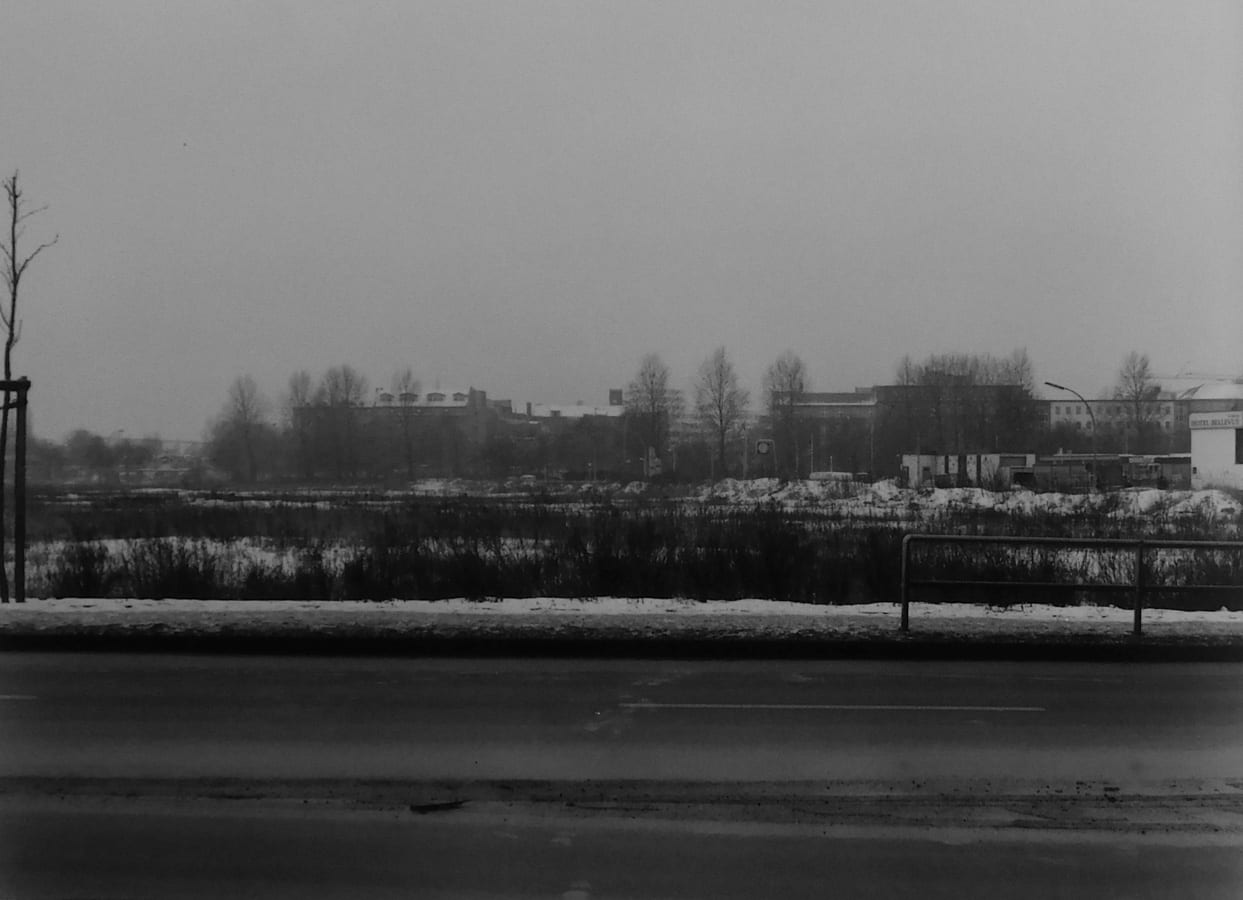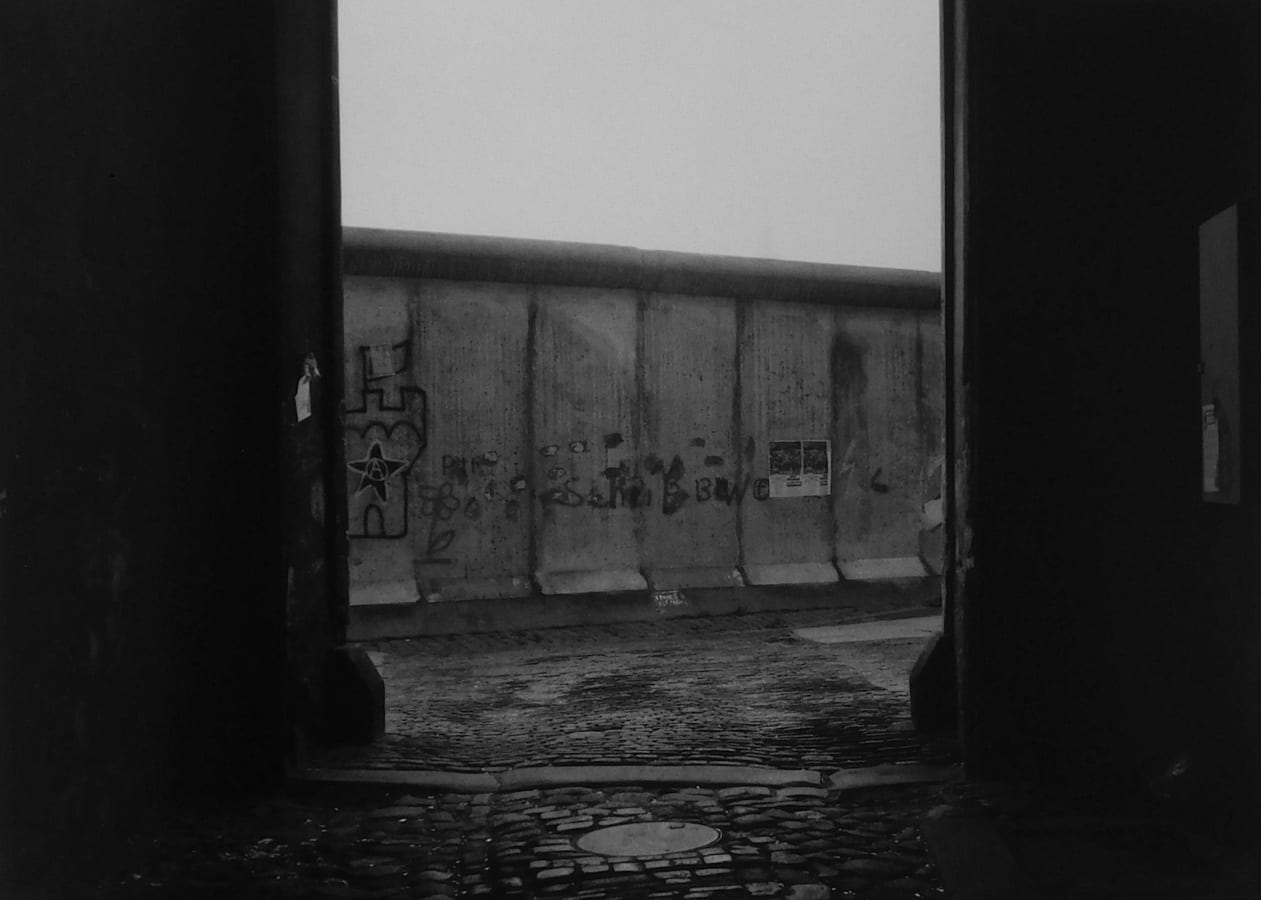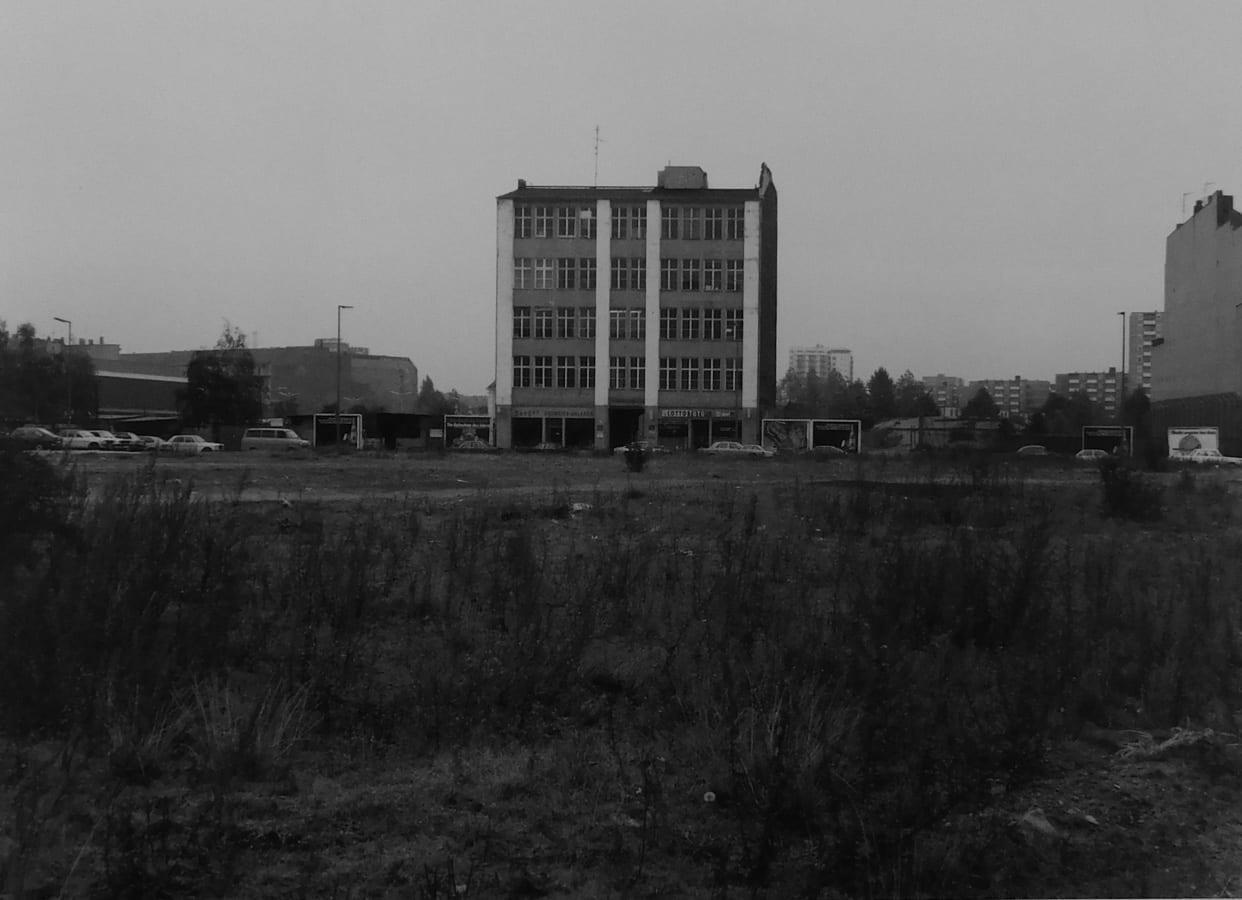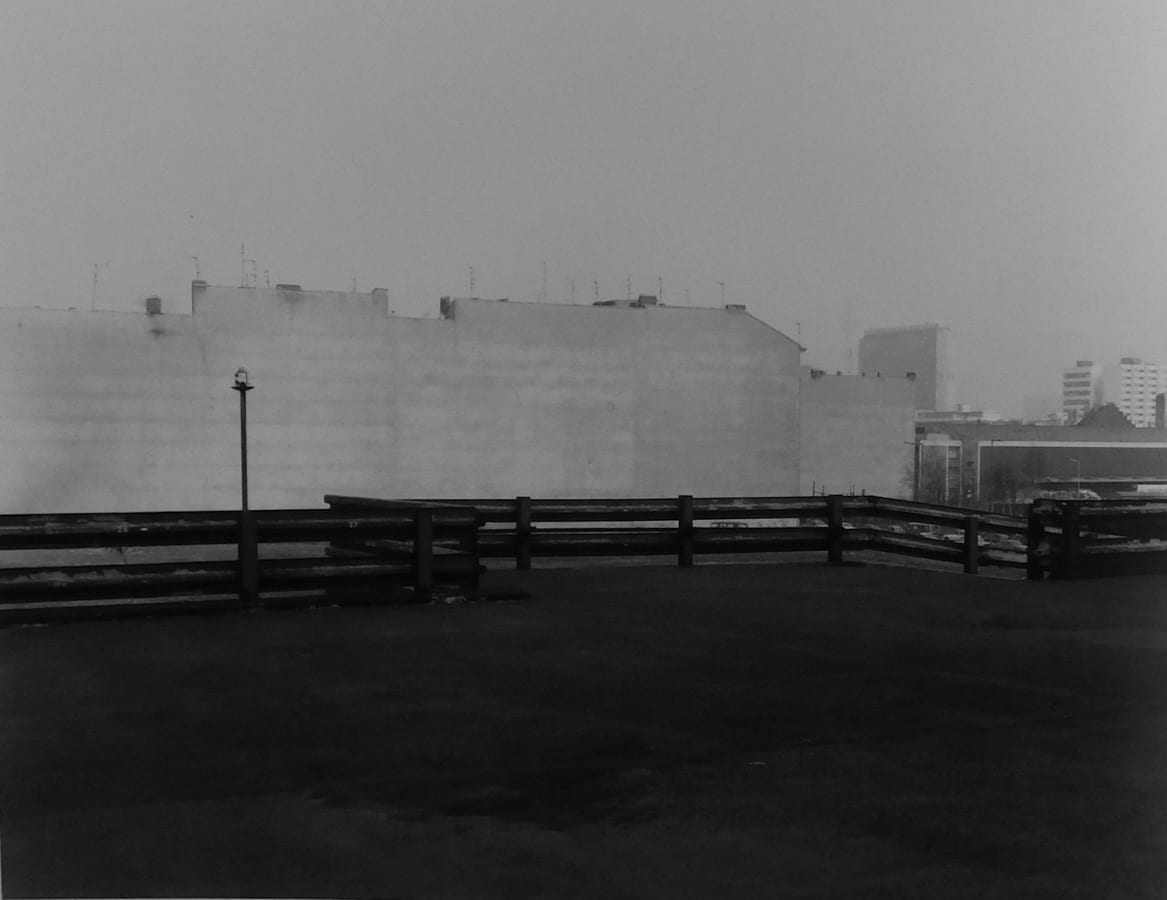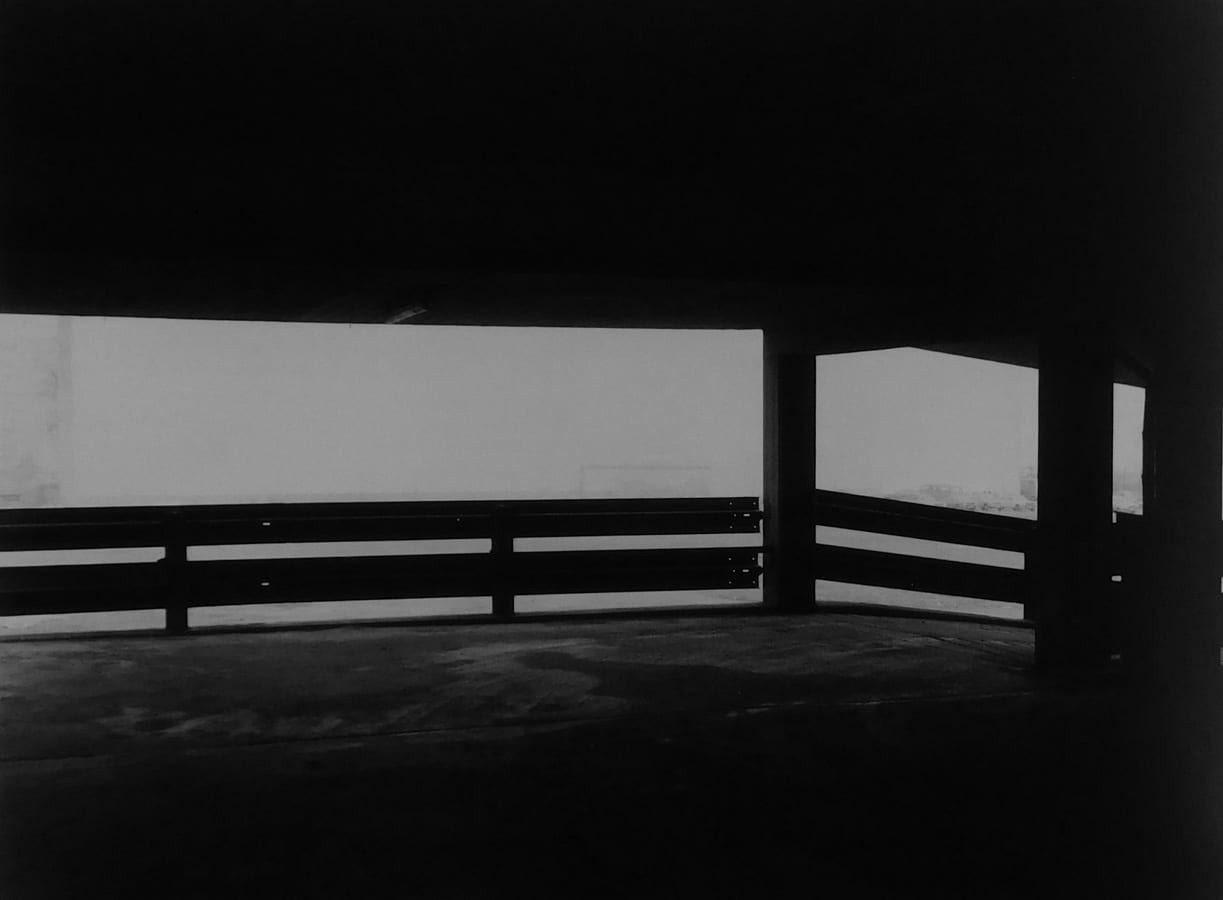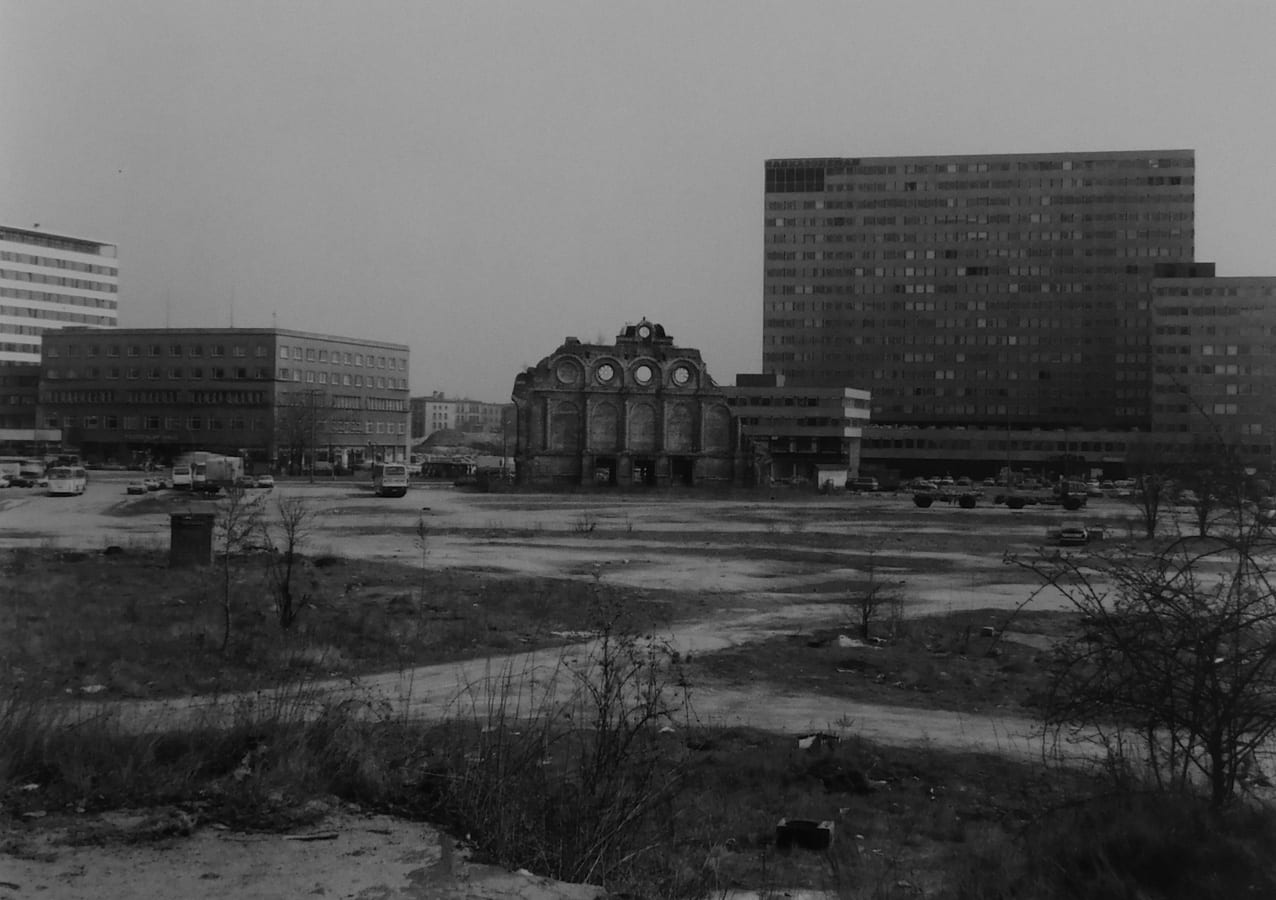“Though the clues to what could be considered “absent” “voided” or “gone” are not to be entirely championed nor ignored, the work follows a circular format. It is an examination of place and home and the subject’s way of seeing the familiar and unfamiliar at the same time. This inquiry of Schmidt’s is adept if not deftly demonstrative.”
Post-war German photographers were masterful in rendering the psychological state between loss, absence and the utter destruction of their home environment after the Second World War. One of the key ways in which they exhibit these concepts is through the use of displaced landscapes and what I will refer to as “looped time”, which is exemplified in a state of muted anxiety in repetition. Michael Schmidt is one of many photographers whose work was conditioned by these propositions in which he transmitted anxiety from contemplation between occupation/identity and division/re-unification in his books Waffenruhe (1987), Ein-heit (1996), respectively. His work also operates in a quiet solitude that quantified loss, but also gave way to a deeper consideration of time, home and absence as seen in his book “Berlin Nach 1945” (2005).
Though ruins appear in some of his works, notably the fragments of Anhalter Station in his work Berlin Nach 45, it is not all about images of direct destruction or decay that Schmidt concentrates on. What is apparent is that his inherent interest, while examining the condition of loss and place in a post-war German photographic context, exempts the traditional modes of production that were focused on ruination and sublimity, eschewing them rather for a certain pathology based on what I see as a series of voids, which bear a distinct lack of punctuating photographic affect of a definable and destructed object of decay (ruin or war memorial) that could overtly objectify his way of communicating. Instead, he preferred a method of moving towards a pure and subjective narrative of what has been loosely associated with the term “aftermath photography”.
Point of Event.
Aftermath photographs are photographic images made of tragic events after the moment and not during. They capitalize on a state of event shock within proximity to the time shortly after a tragedy manifests when high levels of anxiety and trauma are still fresh in an attempt to communicate or process an evaluation of the event, a reportage. In Schmidt’s use of voids, the condition and its lack of shock value define an almost intolerable solitude in his work, which is categorically defined within the agenda of post-war German photography. In the absence of momentary shock lies the presence or the void as a thingness or device of employ, which carries the event itself towards metaphor long after its impact. In consideration of what “Post-War” is to German photography and Schmidt himself, it is important to note that there can be no absolute aftermath as the political situation and the division of community enlarged (pun intended) a wound that could not close under occupation, therefore leaving the moment of needed closure left in a cycle in which anxiety and trauma become looped and cyclical over decades of time surpassing the effect of “late” or “Aftermath”.
David Campany, in his eloquent essay “Safety in Numbness: Some remarks on the problems of late photography”(1) speaks about what can be perceived as Aftermath or late photography in the works of Joel Meyerowitz’s “Aftermath” book in which New York’s Twin Tower’s Post-9/11 destructed mass are documented by Meyerowitz who was the only official photographer allowed access to the site in his capacity as of non-forensic and potentially propagandistic art photographer .
In his essay, Campany displaces the notion of how time and event are efficiently rendered between moving image and still or “freeze” frame. The forensic qualities of the frozen frame are often cited as a more effective way to commence an understanding between awkward nostalgia, cultural memory and how it is broadcast through compressed time, trauma, and event. He goes on to point out that this device functions in conjuring a privileged (not event experienced) discourse of how a still image is used within the categories of popular consciousness or unconsciousness after a traumatic moment. This is a specifically important point as the frozen image in contrast to the moving image offers less information and less evidentiary material from which the active agent of consumption, namely the viewers cultural memory identifies with the still frame in processing the pathos, traumas and nostalgias associated with the image. This is to say that the freeze frame or still image in popular use is employed through its transitory documentary nature of absorption of meaning in one halting effect in which the eye is given less information and perhaps allows for an easier method in which to acquire a surface understanding played out by the convention of nostalgia and the unreal. It also tends toward placing emphasis on Icon-building narratives and Pulitzer Prizes and the problems they incur as I have spoken about previously (2). It is not too much, nor is it too little and it gives access to the viewer to circulate within its more palatable and SLOWER condition to be acquiesced into memory. It stands as a testament, or rather an effigy or monument to the event itself in which nothing too much is asked of the viewer and thus contravenes the validity of the outright examination of critical discourse in documentary or the elevated potential of the moving forensic image.
Michael Schmidt, knowingly or not exemplified this position in his book by arriving late, but adversely became stuck in a series of still freeze photographs in which the event of trauma was ongoing. He gives neither too much, nor too little and lets the subject, through his or her popular unconsciousness draw the necessary associations towards a relativism without concrete enforcement of the documentary discipline, thus allowing the images and viewer to ascertain a certain sense of imagined truth or uncomfortable evolving nostalgia into each image from a multitude of perspectives and inner associations whilst the traumatic moment fails to conclude when viewed from a longer distance of time. This is where the conflation of aftermath, looped time and event become confused with the production of meaning.
“The incredible aspect of this photograph is that its employment of this tactic of subjective epitaph or monologue is almost lost behind the curtain of the empty space, though the feet are lodged firmly in the foreground as if to declare the author’s presence as unofficial or impartial if at work. It is the self-portrait in the citadel of the spectral.”
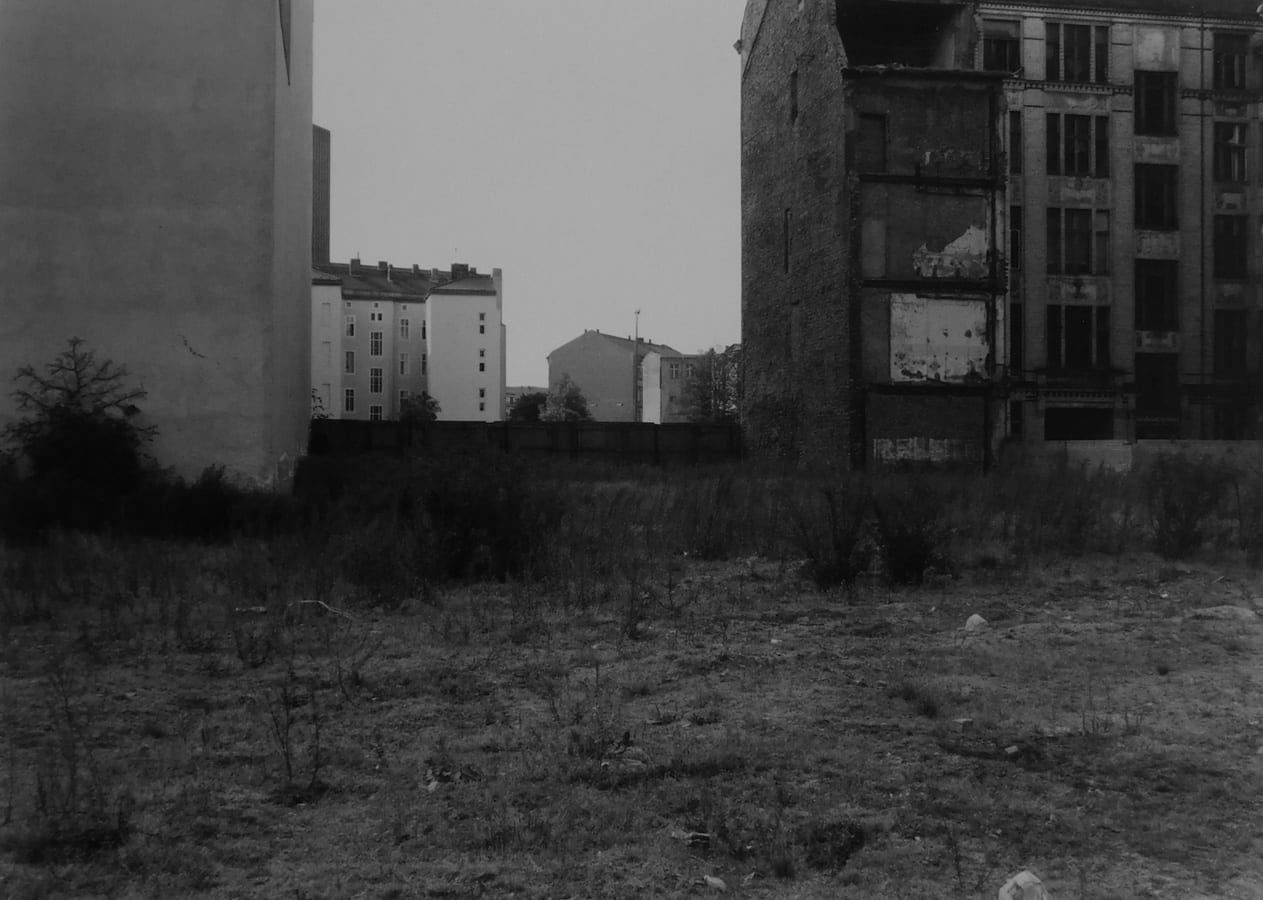
Un-Monument
Schmidt was born in the same year that Germany capitulated to the allied forces and Russia. The year of his birth is significant for several reasons. Primarily, it absolves the responsibility for Schmidt to have been actively engaged in post-war guilt. His birth transcended involvement in the conflict. It is also the formative period for a new Germany in which Schmidt and his generation were co-opted as part of a political chess game that would see social upheaval continue until reunification in 1989-the era of his adulthood. His youth would be spent in West Berlin and yet it would be spent in close proximity to the Berlin Wall, which informs certain bodies of his work, but is not an over-arching shadow. Of note, as Janos Frescot points out in his essay within the book (3), Schmidt moved twice in his youth to East Germany, only to return narrowly in 1953 with an escape back to the west. Thus, though established as a West Berlin Photographer, his displacement in his early years certainly informs a listless reckoning with place and ongoing trauma-in particular the ever-present epitaph of the Berlin Wall.
Regarding the wall, photographer and friend John Gossage had noted upon his own arrival to Berlin in the 1970s, in a recent conversation “the German photographers of the time were by and large almost painstakingly ignoring the wall”. This comment expresses a particular pathos about the political and psychogeographical stigma that the wall and the following decades of political unease and trauma would produce on its local urban image-makers. The act of observance is one of the fundamental principals of photographic practice. In its absence, and counted among so many photographers without confrontation, the wall perhaps stood even a meter taller in the collective cultural (un)consciousness. To confront the edifice, even ignoring the physical potential for personal calamity would be to give into its reality and would diminish the myth and terror it had produced at great cost to the individual photographing it. To photograph or actively engage with the wall would have been an act of resistance to tragedy, which in the chaotic years of 1961-1989 could have political repercussions or in the very least would have been met with a quantifiable reception of sadness, anger, or loss on the part of an image-maker-thus Schmidt’s lack of study of its presence allows a body of work like Berlin Nach 1945 to play into present associations with Berlin as a larger site and by excluding the wall bar one photograph is to give it notice, but to also limit its myth.
There is one glaring and at first read confusingly brutal photograph of the wall within Schmidt’s Berlin Nach 45. It feels like an afterthought and it is certainly not an aftermath study as it was shot during the time of the wall. The placement of this image in Schmidt’s editorial runs about ¾ through the book and in its position, does not give weight to a central access point, nor the beginning or the end of the work. It is simply caught in the loop of the book’s sequence. To ignore its inclusion or to void its presence would have also been to void Schmidt’s exercise within the edit and his refutation to be politicized by outside forces. The power of his observance in this case does not dictate a political posturing. The wall was an inescapable reality and though dwelling on its surface could potentially edify it into political status, ignoring it would do the exactly the same and perhaps to larger ends. It is one brutal and claustrophobic frame. It is a presence in a book of absence.
An Emptiness or Several.
Michael Mack’s note on the Schmidt’s Berlin Nach 45 presents the case for an inclusive study of topographic absence in his book “Reconstructing Space: Architecture in Recent German Photography-“The series is a topography of Berlin’s empty sites, of bombed or undeveloped gaps in street frontages”(4). The focus on gaps or empty passages refers to an inflicted trauma as seen through the absence or void of the past and the recrimination of the German psyche for its involvement and loss of the war itself in general terms. As outlined above, I posit that Berlin Nach 1945 is slightly more complex in its reading than only about what is missing in between the buildings and the wide-open swathes of land, though those points are also of strategic importance. It is more than an edifying approach of hiding the wall in minute segments of photographic document, which it also does and its propositions are adjusted in several more hidden ways.
Seen as largely a book of absence, it is a disservice to read the work without the personal narrative of Schmidt behind the camera, no matter how illusive the subject matter can be in this case. The work is about time, collective brooding, psychological entrapment and inclusively, it is a personal narrative about architecture and home turf. In a broader sense, it is about time and home. Though the clues to what could be considered “absent” “voided” or “gone” are not to be entirely championed nor ignored, the work follows a circular format. It is an examination of place and home and the subject’s way of seeing the familiar and unfamiliar at the same time. This inquiry of Schmidt’s is adept if not deftly demonstrative.
In the book, we engage with a very small area of Berlin from the ruin porn of Anhalter Station through the familiar area of Kreuzberg, particularly the area of Mehringplatz. The images move frame by frame towards the cinematic, but never give into forensic governance. In no small way, they resemble location scouting photographs (a lost Trümmerfilm) or perhaps mundane urban planning documents (a parking lot here, the new mall over there). They are nearly devoid of people (You can find some very small fairies if you look, purposefully squashed into match head stature) and movement (the cars as stoic as the shops and weeds) and move in a circular motion by returning to locations over the length of the sequence. From this position, the viewer feels as though they are pacing along with a solitary figure who leaves his doorway early one morning by dim grey light and returns home later in the same haze of dim grey light and not clearly understanding why it happens daily-perhaps a gesture of being trapped in a film not dissimilar to an even more dystopian “Ground Hog’s Day”. This is the gift of Schmidt’s use of circular/loop time within the work imbued from routines and the repetitive display of his home and neighborhood left unobserved or perhaps left wanting from an outside inquiry. It literally catches the viewer in the process of a loop. Everything is flattened by printing method (this technique started with his book WEDDING), but also by lighting and the path trodden by Schmidt. The primary feeling is one of desperation, of being entrapped by the snares of history and a political voiceless-ness-a solipsistic and uncomfortable weight of pressure through the metaphor of the neighborhood’s daily walk as a ritual for the burdened psyche that wishes to observe, but not orate through the spectacle of the traumatic. Perhaps a further nuanced layer of the work could also inquisitively and rather bleakly simply ask “what is next” or “Is there a next”? This again alludes to not only notions of a future, but also the annexation of the inescapable and looped present calibrated by an inability to displace trauma with a reconciliation of an ending of political horror and compression.
Digging in, Digging Out.
Vacant lots appear in which new buildings should sprout and teem with life, and as an outside observer, given the title and place, the first encounter with this book is to look for edificial scars that never healed from the strafe fire or incendiary flashes from a time in which bodies softly decompose under rubble-strewn streets and instead we are left with a metaphorical archaeology in present time and tense. We unearth meaning through emotional and historical digging and place value to the absent consideration of elements not affixed to what was previously concretized by the foundation of a ceasefire. It is a living archaeology that started in 1945 and did not end. It is a continual excavation of identity and of the forensic nature of removed and invisible architecture. The idea of a living archaeology may be a sinuous if imperiled metaphor for the idea that Schmidt was attempting in his quest as mentioned previously, as it is not meant to be seen as an objective analysis. Rather, the present living archaeology is subconscious and is more about the inner-consciousness and the unearthing of psychological and emotional states of the author stuck in a loop and not simply the collective memory. Schmidt seeks to brush away the surface debris of being in order to examine the foundations and cultural artifacts of a self-compacted and stateless anxiety of a destruction one did not bear witness to, but had been told about in conversation over and over again-exhibiting another act of circular time and trauma in effect. The result is in a way anti-iconographic.
“The images move frame by frame towards the cinematic, but never give into forensic governance. In no small way, they resemble location scouting photographs (a lost Trümmerfilm) or perhaps mundane urban planning documents (a parking lot here, the new mall over there).”
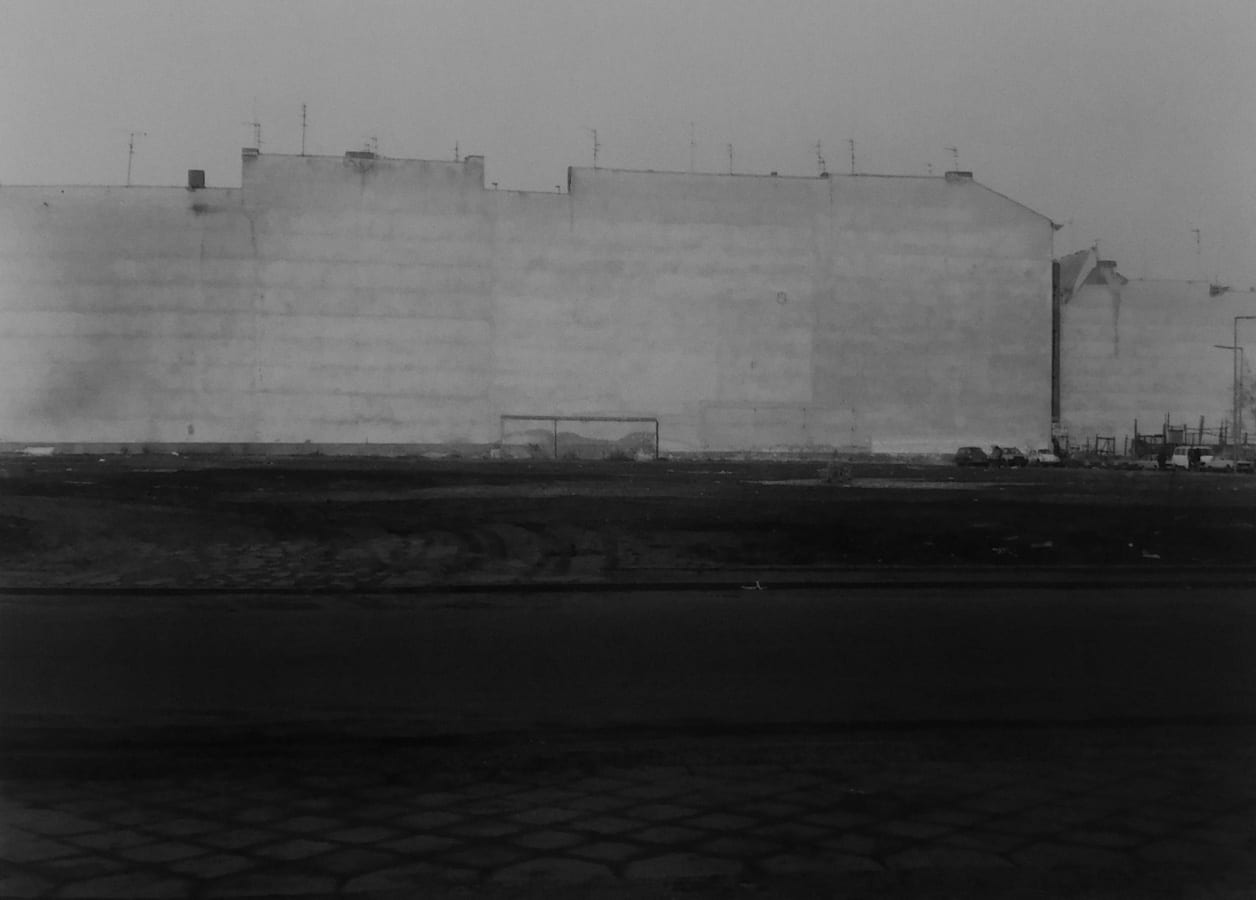
Time and Forensic Edifice.
Within Berlin Nach 45, an element of the circular and the spectral is not considered by many reviews that I have read of the book. When I speak of location and circular/looped time, I am contemplating the idea of a philosophical exchange in which geological or chronological time is ignored for the sake of the metaphorical found consistently in the loop patterns and the “digging” of psychological state that I mention. It bears some scrutiny for its similarity to the concept of “eternal return” in which there are acts of completion of universal order (death, ego or other) before an energy or psyche is thrust back into the genesis of a recurring cycle. Like Groundhog’s Day, the cyclical narrative is possible through its repetition. It is a state of being caught in a condition that alludes to a self or protagonist that is caught in the amber and put on repeat in first and third person simultaneously. The identification with self and environment is about stasis and not a change of position as within a eternal return where self and author are recycled into new form doomed to repeat the same sequences ad infinitum, unconscious to the fact. This is about inescapable boundaries that exist in a space of mental or psychological and philosophical exhaustion.
Schmidt’s former occupation as a policeman also features heavily in this body of work and we begin to develop mini-narratives of place within that allude to forensic case studies. We begin the book with the consideration of being straddled between a large parking lot on our left and a colossal wall to our right. The images of the car park and the building on the right surface again halfway through the book as if to remind the operator or audience that it has an intentional charge to be reconsidered later and AGAIN. Something about it reads like a post-it note. Towards the end of the book, we indeed find ourselves, through succinct editing (if at outset inscribed as random) back at the car park, but this time, we are the observed observing the previous position of Schmidt from between the open-air guardrails of the structure and from the elevated top floor of the ramp. From this position, we also look at the same building on the right. There is a reason for this. It plays with the idea of a situated observer or in this case the photographer whose position is viewed from various points in which we assume he has one position or one linear chronological path to progress, but is rather caught metaphorically re-examining the possibility of his own doppelganger and being observed by them in the loop. The forensic qualifications can be suggested as an approach only so much as it is a device that enables an awareness to being stuck within the cyclical paradigm of the loop itself and not a proponent for documentary explication. To photograph the façade and to be inescapably drawn into its interior would be to promote the idea of a natural investigative practice, whether crime or other is up to the viewer. The importance of this image however, is that Schmidt does not focus on the interior, but rather looks back out and over his previous position on the street. There is an ascent and a delay, or is it the other way around?
The parking garage is but one example in which Schmidt stalks various pieces of terra (in)cognito in the work. The other more obvious system of locations include Anhalter Station and the lotto late night shop in which Schmidt looks from across a vast swathe of now empty land and in which the shop in rendered in small minute detail from a different position. Later and in almost uncomfortable proximity, the same lotto sign hovers over the frame almost imposing a larger than life presence when considered from its diminutive scale in the preceding image. Anhalter itself is a more difficult contemplation as the desire to see the decayed tooth of a monument for what it is-a vestige of the war and a monument to death cannot easily be ignored. However, the ruin itself is given equal measure to the post-war housing and office blocks that also form repletion within the work, therefore decreasing the overall consideration of the location as a defining principal of thematic ruination. It simply exists along the path. The whole of the book reads as a potential forensic site.
Of Anima and Traces.
Two images within Berlin Nach 45 give a human presence to its otherwise devoid illustration of a city and its negated human topography. The first of these images is introduced within the book, but in a quiet way. From across the street, Schmidt has photographed a large open space-the feeling of Agoraphobia is palpable. However, and likely on purpose, Schmidt has imbued the photograph with the heaviest of presences-the dirt or snow-shedding footsteps of the photographer himself. The asphalt has picked up the trace of the ghost behind the machine. The incredible aspect of this photograph is that its employment of this tactic of subjective epitaph or monologue is almost lost behind the curtain of the empty space, though the feet are lodged firmly in the foreground as if to declare the author’s presence as unofficial or impartial if at work. It is the self-portrait in the citadel of the spectral. One could even argue that its inclusion could border on the egotistical given the scope of the void. From a cinematic point of view, this is to extrapolate for the role of the artist as conqueror of domain, akin notably in the films of Werner Herzog, where empathy is forsaken for that of the inclination to dominate the indomitable. And here it is no different; it is Schmidt’s way of harnessing a control over history, over home and over position of ego within the work. By using his camera as a shovel, Schmidt had removed alternate possibilities for inclusion of narrative by enforcing a demographic presence in trace form. He in no small way forced an evacuation of Berlin by self-inclusivity and populace exclusivity.
The second and in some ways declarative challenge to the above perception of the portrait in the work, is the images that refer to the broadside of an apartment (situated across from the parking garage) or housing complex in which the building that previously hinged itself to its lumbering side wall has been removed. The edifice of what was left has been paved over by cement or plaster, but due to the elements, the faint image of dwellings begin to appear in horizontal lines in which the imaginings of pre-war bedrooms and toilets are imagined with the removal of the former building that used to abut it given over to a parking lot. In the second half of the twentieth century, the parking lot ruled Berlin, see also Hitler’s bunker. The coarse outline of each individual habitation or interior room is seen through the exterior of this side of the building culminating in not one ghost, but rather a whole community of them. Here again is where the void presents back to the viewer instead of drawing it into itself like a nebulous and absorbing black star. The only thing missing is a view from one of the rooms inside. The forensic state lies in the architecture and not the death of people itself.
The grandeur of Berlin Nach 45 lies unequivocally in the viewer’s ability to inhabit the frame. Without being able to walk with Schmidt (post-humously) and without being able to be stuck in a loop of familiar unfamiliarity, the book would systematically suggest an inappropriate sideways glance into the abyss through the miscommunication of the banal or perhaps the ungovernable qualifications of oppressive guilt that Schmidt would not have considered as his own as it would be merited by grounding itself in the characteristic and obvious employ of absence and only then by absence as metaphor. The work would be absorbed in conclusions drawn from a selective and enforced collective historicity consulting the amnesia that precedes the end of guilt. This is not the perspective of Schmidt, nor can it be of the viewer so many years later. What is important are the traces, the audible clap of heels on stone and the hollow reverberations from those movements on the rubble between buildings or the clack of the echoing pavement from the interior of the parking garage turned film still.
Reading the work as a credible interference into absence, is not incorrect, but in doing so would serve the author and viewer an injustice as to speak on absence in this case, one must be part of its defining presence-an impossible task given the birth of the author and the presumed (not clinical) age of the audience for this work at present. What we may consider rather is the void in which the quantifiable aspect of absence is grounded on the concepts of time, self and repetition, rather than the unrecognizable features of the vacant areas and Aftermath considerations.
Much has been made about the psychogeographic tendency towards flanneurism in works of “street” photography. From Brassai, whom Schmidt was fond of to many others, the flanneur’s irresponsible responsibility was to be lost, to let an automatism take over his or her wander through the city so as to value its quarters, streets and populace from an alien position-it was to do away with familiarity for the sake of new experience or oblique perspective. In Schmidt’s work, it’s hard to fight the notion that the role of a flanneur could easily disrupt the flow within due to pressing forward with the unknown prescription to wander. The work in which Schmidt inhabits as outlined previously is that of a familiar unfamiliarity by way of topography, but also living inner archaeology of subjective meaning caught in the hammering effect of displacement in a known, yet unfamiliar home turf. In truth, it is a unique position that he inhabited. He was able to see his home turf as foreign and familiar in equal measure and his steps and inquiry showcase this to a large degree. That he was stuck as an errant detective in the void of loops and decay is but a few features of the pathos of emptiness that inhabited Berlin and Schmidt’s work in Berlin Nach 45.
(1) ‘Safety in Numbness: Some remarks on the problems of “Late Photography”’, first published in David Green ed., Where is the Photograph?, Photoworks/Photoforum, 2003.
(2) Feuerhelm, Brad, “Hollywood, Ankara: Superfamiliarity and Terror”. 2016. http://s927299661.websitehome.co.uk/2016/12/hollywood-ankara-superfamiliarty-and-terror.html
(4) Frescot, Janos. Preface. Berlin Nach 45. Steidl u Eskildsen, 2005
(3) Mack, Michael. “Reconstructing Space: Architecture in Recent German Photography-“ Architectural Association. 1999. pg.58
(All Rights Reserved. Text @ Brad Feuerhelm. Images @ Michael Schmidt.)
